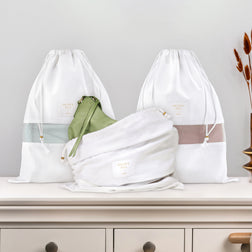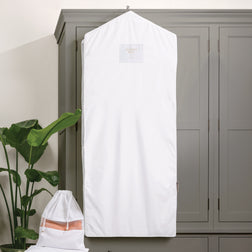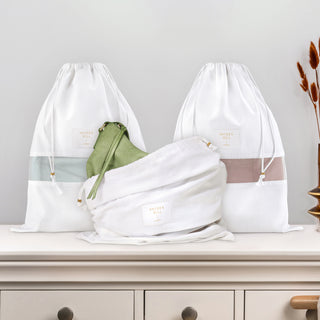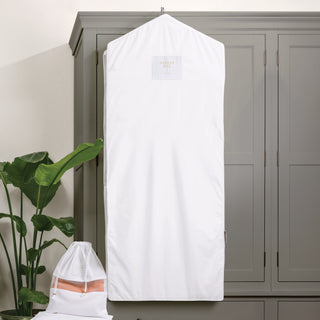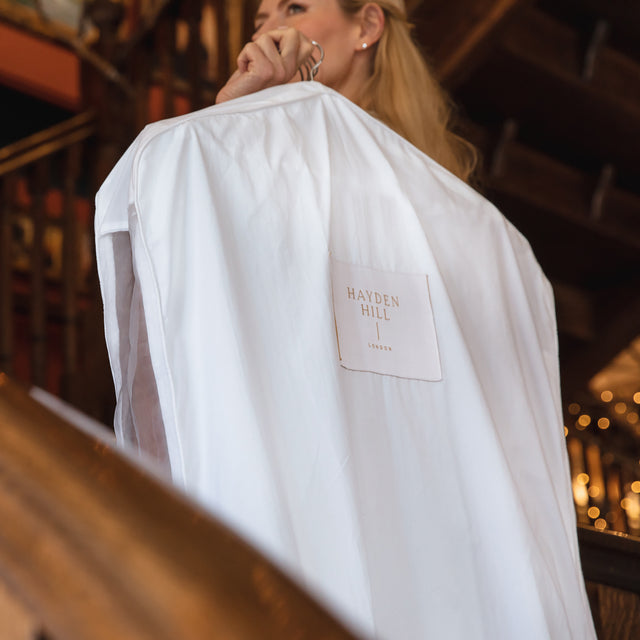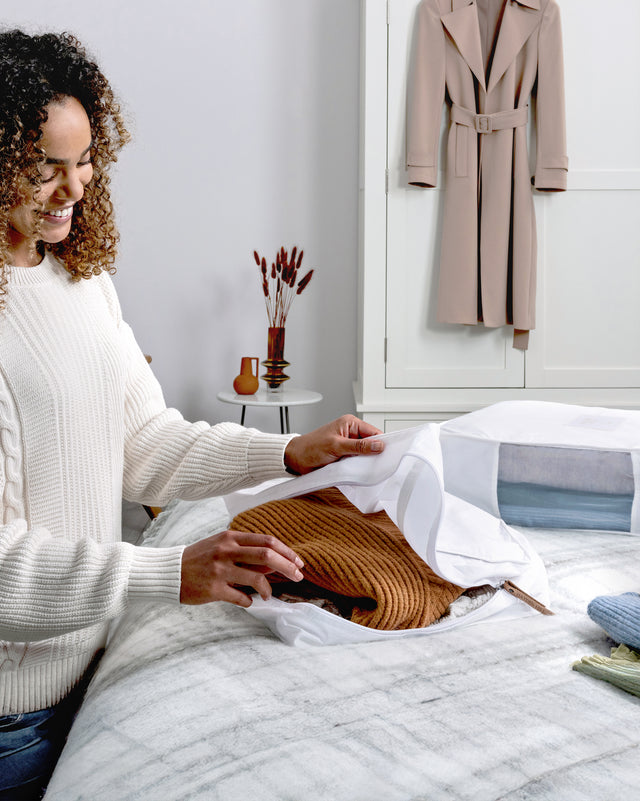Cashmere may be in a class of its own because of its luxuriousness, but it is still a type of wool fabric.
So what is the difference between cashmere and other types of wool?
The differences aren’t always obvious, so it’s important to know what to look for so you will be able to spot marketing tricks that try to sell you something that’s not worth the price tag.
Are Cashmere and Wool the Same?
Wool is the textile fibers typically collected from sheep but also goats, musk-oxen, rabbits, and certain breeds of camel. It is made of a protein called keratin, which is the same protein found in human hair.
If the tag on your garment just says “wool” and does not list any other identifying information about the textile being used, you can assume it’s sheep’s wool. The tag likely doesn’t specify what type because the wool isn’t from a region or breed that warrants specific identification.
- Cashmere: Also known as pashmina wool, this textile comes from a special breed of goat that originated in the Kashmir Valley, near the Himalayas.
- Merino: Merino wool is one of the world’s most popular types of wool. Good quality Merino wool is soft to the touch, incredibly comfortable to wear, and less expensive than cashmere.
- Lambswool: Also called virgin wool, lambswool is sheared from young sheep. It is smooth, soft, wrinkle-resistant, and hypoallergenic. Lambswool is a more expensive type of wool because a single sheep can only make lambswool once before maturing.
-
Alpaca: Alpaca wool is very versatile and is used in bedspreads, blankets, suits, and outerwear. It is prized for its lightweight durability.

- Angora: The hollow fiber that makes up the Angora rabbit’s fur is favored for its efficient insulation, but it is extremely fragile.
- Llama: The fine undercoat of a llama is suitable for use in clothes and crafts, while the coarser guard hairs can be used to make more durable items, like rugs and ropes.
- Lopi: Icelandic sheep provide this type of knitting wool, which is spun using a unique process that creates a thread with a tough outer layer that has water-resistant qualities.
- Mohair: Angora goats produce the natural fibers used to make mohair textiles. These goats offer a combination of thick guard hairs and fine undercoat.
- Tibetan: Somewhat misleadingly named, soft and curly Tibetan wool is shorn from Tibetan lambs, but they are usually raised in China rather than Tibet.
- Shetland: A thick, coarse wool due to the breed’s origins being a cold climate, the Shetland Islands of Scotland.
- Qiviut: The arctic musk-ox, bred in Alaska and Canada, sheds an undercoat that breeders gather to make a textile that can be eight times warmer than sheep’s wool. Its warmth is highly valued in these cold climates.
Even with all of these choices in natural fibers, cashmere continues to maintain its luxury status in the textile industry.
Why is it more coveted than these other types? Let’s explore the differences.
Is Cashmere Warmer Than Wool?
As the world’s most luxurious wool textile, how much warmer is cashmere than Merino wool, or than wool from other breeds?
Most industry professionals believe cashmere to be at least eight times warmer than Merino wool.

Cashmere doesn’t have the ultra-insulating properties of qiviut, which is made in the arctic. But, qiviut isn’t as easy to find as cashmere, so cashmere is one of the warmest textiles that’s also readily available and relatively affordable.
Which is More Expensive, Wool or Cashmere?
Cashmere’s reputation as a prized fabric may be somewhat deceiving - it is not the softest, warmest, or most expensive type of wool. It is the balance of its texture and insulation compared to the cost of its production that sets cashmere apart.
Overall, few types of wool can compete with the expense of cashmere and the willingness of the market to pay that cost on a recurring basis. Buying and wearing cashmere is no here-today-and-gone-tomorrow trend, but a timeless standard.
You may be able to find a cashmere sweater for less than a Merino wool sweater, but that’s due to a variety of reasons. Where the animals are raised can impact the price as much as the fashion house who designs the garment.
No matter what you pay for it, cashmere’s value endures far longer than many other types of wool pieces.
Is Cashmere More Durable Than Wool?

Natural fibers’ durability are tricky to predict. When processed correctly, these fibers can be spun to form some of the most resilient textiles known to the world. However, if subtle changes in their environment occur, they become incredibly and sometimes irreversibly fragile.
The softer and shorter an individual fiber is, the less durable it is. Coarser, longer pieces of fiber cling to one another better and have greater resilience.
Much like measuring warmth and expense, it matters exactly what type of wool you’re comparing to cashmere. In comparison to lambswool, cashmere has more durability due to being shorn from mature animals rather than young ones.
However, if you compare cashmere to any other type of wool, it is less durable. For this reason, many manufacturers blend their cashmere with sturdier wools to make a more durable garment.
How Do I Wash Cashmere and Wool?
As with any garment, the manufacturer’s label is the first place to start for cleaning guidance and information, so check it for any special instructions. Otherwise, it’s safe to assume that hand-washing with a mild detergent in lukewarm water will keep most natural fiber garments fresh and stain-free.

Drying natural fiber garments requires careful planning, because you can’t hang them like you might a cotton or synthetic blend. Wool garments lose their shape easily, especially since water makes them fragile and very vulnerable to damage. Unless otherwise specified on the garment’s tag, you should plan to air dry wool pieces by laying them flat, out of direct sunlight and away from heat sources.
How Do I Store Cashmere and Wool?
Storage is another topic we talk about often, because natural fibers are most vulnerable to damage when they’re in storage.
Any storage prep begins with thoroughly cleaning your garments and textiles as described above, which includes allowing each item to dry thoroughly.
Though we have an in-depth guide on storing cashmere, the general rule for storing cashmere and other types of wool is to fold items rather than hang them. A wool item’s own weight can be enough tension to stretch the bonds between each strand of yarn loose.
It’s also important to ensure your valued items are protected from clothes moths. Clothes moths feed on animal fibers like cashmere and thrive in dark areas like closets. Even a minor infestation can completely destroy your pieces. We recommend using moth traps in your closets and choosing moth-proof garment bags to store your items when not in use.
Hayden Hill garment storage bags preserve the beauty of your clothing. Our bags are made of organic, soft cotton with a sheer, organza side panel so you can see your pieces while keeping them protected from light, dust, and moths. Hayden Hill delivers sustainable and beautiful garment care to protect what you love.
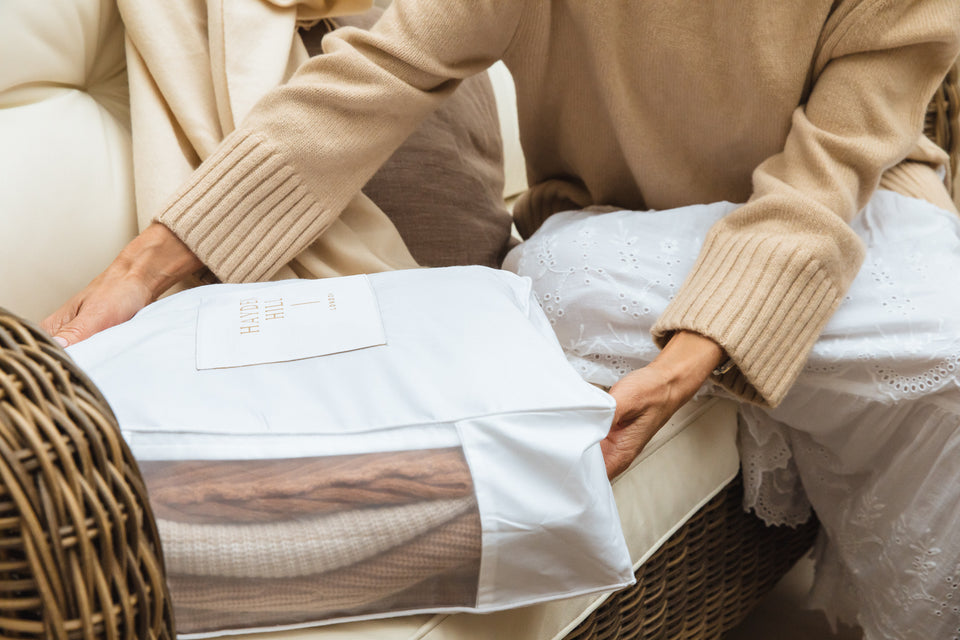
Help! My Cashmere or Wool Piece Stretched and Needs Reshaping!
First: don’t panic. Even though natural fiber textiles like cashmere and wool can be quite fragile and lose their shape, it is possible to restore them to their original shape.
Try the following steps to rescue a misshapen wool garment:
- Allow the garment to soak in mild soap and lukewarm water for 10 minutes
- Wash the item as you normally would
- Rinse clean with lukewarm water
- Squeeze, but do not twist, excess water
- Lay flat on a towel and gently roll up to soak up remaining water
- Unroll and reshape to garment’s original form, allow to air dry completely
- If the item has shrunk by a significant amount, repeat while carefully and evenly stretching the garment back to its original size a little more with each repetition
How Do I Stop Wool From Itching?
Remember that not all wools are made the same, so if one type of garment makes you itch, the first thing you can do is switch to a softer type of wool.
Most wool is gathered from a coat that contains fine, soft undercoat hairs and coarser, thicker guard hairs. The more of those downy, fine undercoat hairs your garment has, the softer it will be - and, the youngest animals of any breed will yield the supplest textiles.
If you love a particular item, but it is itchy and you want to make it softer, you can wash it and then follow up with a wool-safe conditioner. This strips away any potential build-up that could be causing the itchiness, then coats the fibers of the textile with a softening agent. Always check your garment tag for tips, and test any new products on a patch of unseen material for colorfastness.
Cashmere is likely to continue its reign as the most sought-after natural textile on the market. That’s why we want to help you care for your clothing investments properly so they will last for years to come. Our collection of hanging garment bags and clothes storage bags can be the solution for your garment protection.
